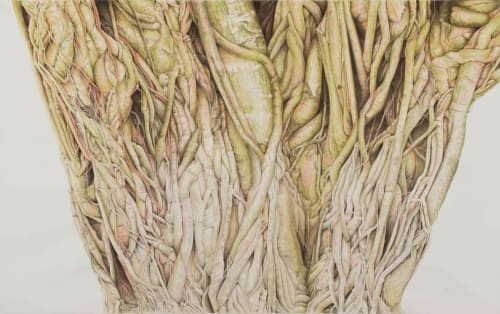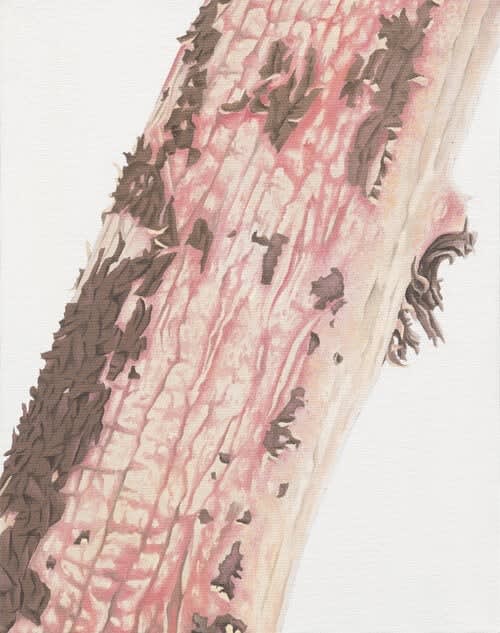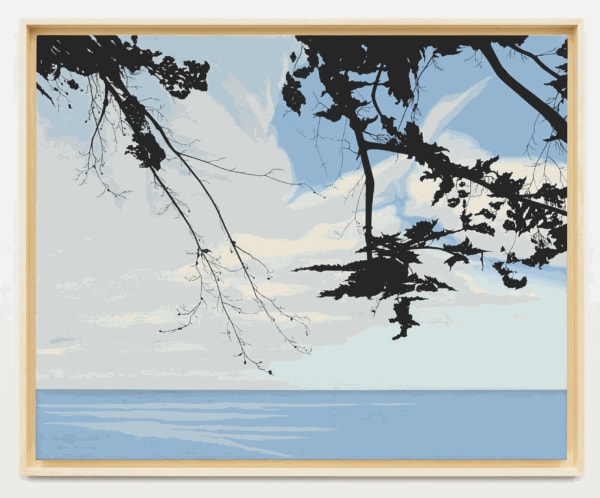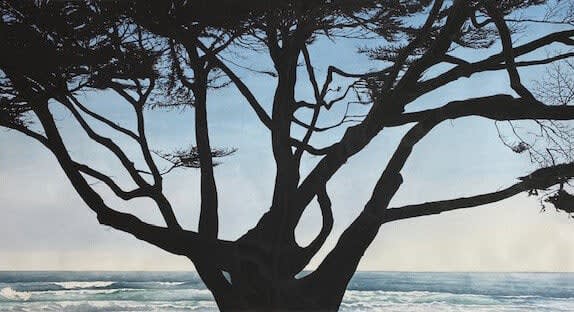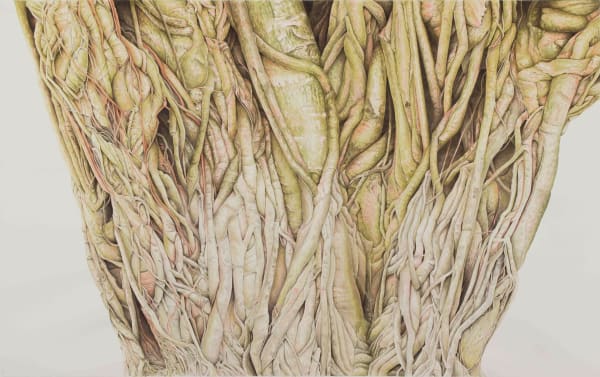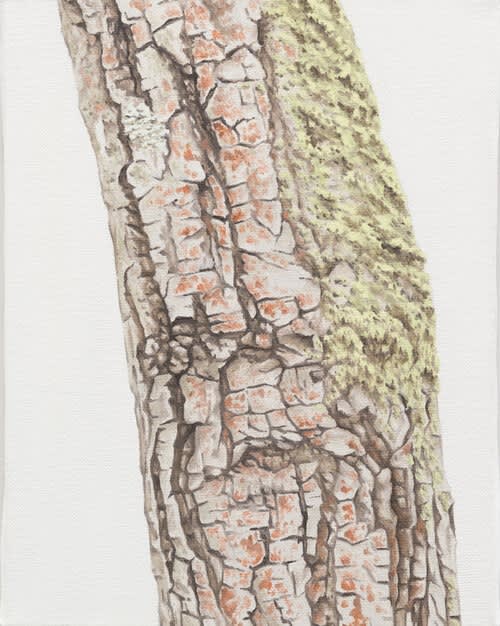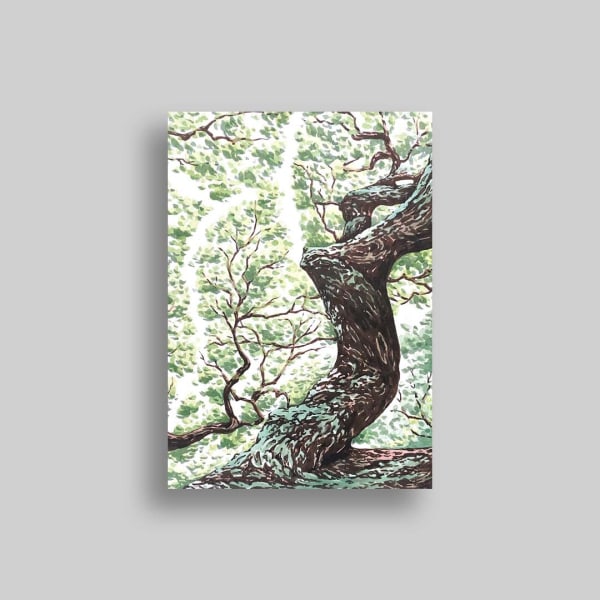Sean Cavanaugh b. 1969
"Often trees are the oldest living members of the environment, and some are the oldest life forms on Earth. It is my hope that my work expresses some measure of their presence, quiet wisdom, and beauty."
Sean Cavanaugh's meticulously compositions are often intimate in scale but expansive and powerful in scope and ambition. His sensitive and astute approach to nature studies conveys an increasing sense of urgency today, as the natural environment becomes ever more threatened by recent attempts to reverse environmental protections throughout this country and abroad.
Due to the artist's commanding technical ability, a botanist would be able to easily recognize the various species of trees that Cavanaugh focuses on in his work. However, with his subtle and stunning nuances of tone and texture, Cavanaugh's work, on some level, advances the possibilities of pure painting. The painterly aspect of his endeavor is befitting an artist who grew up surrounded by paintings-those of his mother March Avery, and his grandparents Sally and Milton Avery-all artists whose work reflects a special reverence for nature.
Born in 1969, Cavanaugh received a Bachelor of Arts degree in both art and environmental studies from Pitzer College in Claremont, California. Having developed his own inimitable painting style over the years, Cavanaugh has held numerous solo gallery and museum exhibitions throughout the country, most recently at the Lowe Art Museum, University of Miami, Coral Gables, Florida.
I have always been drawn to the natural world as a subject of my work. Distilling the space, light, and atmosphere of a place is constantly challenging. Painting a location forces you to truly embrace all of the individual elements in an attempt to translate its personality to the viewer. Once I have painted a landscape, I feel I know it intimately and have internalized a small fraction of its uniqueness.
My fascination with natural forms emerged early in my artistic life, when I was taken with rendering the sky as a landscape. I was influenced by a painting professor who one day declared that we would go outside and paint watercolors of clouds. Great clouds were rare in Southern California and it made me appreciate their constant evolution—at times both solid and transparent, able to absorb and reflect light and the energy of the sky.
After years painting traditional landscapes, I started to focus my attention on isolated elements as a way to express the experience of the whole. I began painting rocks and boulders removed from their surroundings and painted on linen or paper without providing any clues as to scale or environment. The solitary stone became a landscape unto itself, easily abstracted by the viewer’s own perspective. Zooming in on these “contained” landscapes gave me a new appreciation for the infinite patterns and beauty hidden in the microcosms around us.
Another key turning point for me occurred several years ago, after traveling to Tobago. I was overwhelmed by trying to represent the complexities of the densely layered vegetation I encountered there and, so, began working on a series of botanical patterns in silhouette. With the riotous backgrounds muted, I could concentrate on the most interesting forms without distraction. And more recently I revisited clouds, taking lessons learned from the boulder and silhouette series by painting them individually with dense graphite backgrounds. Their ambiguous forms became islands, icebergs, and true Rorschach tests for the viewer.
My latest body of work focuses on tree trunks, both standing and fallen. While hiking I find myself instinctively scanning the landscape for interesting trunks, only realizing what I have been doing when I discover a potential subject. As in some of my earlier work I find that the removal of all other information about the scene lets one more deeply appreciate the texture, detail and individuality of each object. Just as a crowd makes it impossible to measure one person’s face, so does the forest make it difficult to see an individual tree. Often trees are the oldest living members of the environment, and some are the oldest life forms on Earth. It is my hope that my work expresses some measure of their presence, quiet wisdom and beauty.
Sean Cavanaugh
August 2016
-
 Pacific Grove Lean, 2021Watercolor and gouache19 x 43 inches
Pacific Grove Lean, 2021Watercolor and gouache19 x 43 inches -
 Trunk No. 7,, 2013Oil on canvas8 7/8 x 6 7/8 inches
Trunk No. 7,, 2013Oil on canvas8 7/8 x 6 7/8 inches -
 Trunk No. 6, 2013Oil on canvas8 7/8 x 6 7/8 inches
Trunk No. 6, 2013Oil on canvas8 7/8 x 6 7/8 inches -
 A Tattered Veil II, 2015/2023Oil on canvas40 x 50 inches
A Tattered Veil II, 2015/2023Oil on canvas40 x 50 inches -
 At the Edge of the World, 2020Watercolor and gouache on paper20 3/4 x 37 inches
At the Edge of the World, 2020Watercolor and gouache on paper20 3/4 x 37 inches -
 Monster in the Church Yard, 2019Watercolor on paper34 1/2 x 54 inches
Monster in the Church Yard, 2019Watercolor on paper34 1/2 x 54 inches
-

A Certain Form of Hell
Karma Gallery, Thomaston, Maine 20 Jul - 31 Aug 2025As above, so below—every vision of heaven is mirrored by a depiction of hell. Paintings of the Last Judgment throughout the millenia, from Jan van Eyck to Michelangelo to William...Read more -

A Particular Kind of Heaven
Karma, Thomaston, ME 21 Jul - 1 Sep 2024A Particular Kind of Heaven presents a wide array of empyrean imagery by a multigenerational group of artists. Sited in a deconsecrated Catholic church, the exhibition probes connections between the...Read more -

Eyes on Nature, the Art of Sean Cavanaugh
Morris Museum, Morristown NJ 23 Feb - 26 May 2024On view in our historic Bickford Gallery, Eyes on Nature, the Art of Sean Cavanaugh brings together a selection of works highlighting Cavanaugh’s watercolor, oil, and gouache depictions of trees,...Read more -

CAVANAUGH & PROSEK
17 May - 31 Jul 2022Read more -

SEAN CAVANAUGH
Under The Elder's Gaze — Yares Art 2 Aug - 28 Sep 2019YARES ART is pleased to present Sean Cavanaugh: Under the Elder's Gaze, an exhibition of recent works centered on intimate nature studies. The show appears at YARES ART, Santa Fe,...Read more
Michael Abatemarco, “Life and Limb: Sean Cavanaugh’s Arboreal Art,” Pasatiempo (August 23, 2019).
